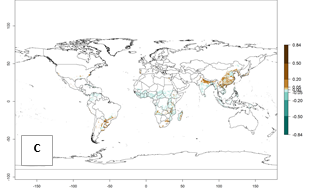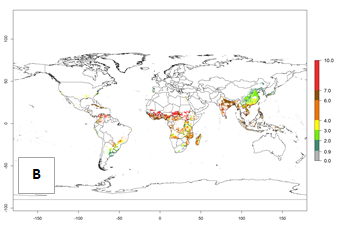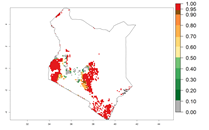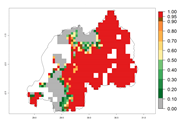4.2.1 Sweetpotato Pests / Sweetpotato weevil, Cylas puncticollis (Boheman 1883) ![]()
Synonym: None
Taxonomic position: Insecta, Coleoptera, Brentidae
Authors: J.S. Okonya, N. Mujica, P. Carhuapoma, & J. Kroschel
Common names
African sweetpotato weevil (English), schwarzer Batatenkäfer (German), picudo africano de la batata (Spanish), charançon africain de la patate douce (French), gorgulho-africano-da-batata (Portuguese)
Hosts
Sweetpotato [Ipomoea batatas (L.) Lam.], Morning glory (I. eriocarpa R. Br.), Beach Morning Glory (I. pes-caprae (L.) R. Br.), Wild Potato Vine (I. pandurata (L.) G.F.W. Mey), Water spinach (I. aquatica Forssk), Cotton (Gossypium hirsutum (L.), Astripomea lachnosperma (Choisy), Keznaf (Hibiscus cannabinus L.), Abuta (Cissampelos pareira L.).
Detection and identification
Cylas puncticollis damages leaves, stems, and roots of sweetpotato. Root damage is a result of (1) the presence of fecal matter covering oviposition holes in the root—infested roots have black spots on the skin where eggs were laid and can easily be noticed at harvest; (2) feeding punctures of adults on the root surface (Photo 1A); and (3) extensive larval tunneling and feeding (Photo 1B). Stem damage is due to larval feeding at the stem base causing the vines to swell and eventually wilt or die. Inside the root or stem, larvae feeding creates irregular galleries in the inner part of the root or stem (Photo 1C, D). Typical symptoms of leaf damage are holes caused by adult feeding on the epidermis, especially when the roots are not yet formed (Photo 1E, F). In instances of severe infestation, adult feeding on stems during early stages can cause sweetpotato vines to be completely eaten up, resulting in failure of the plant to establish.
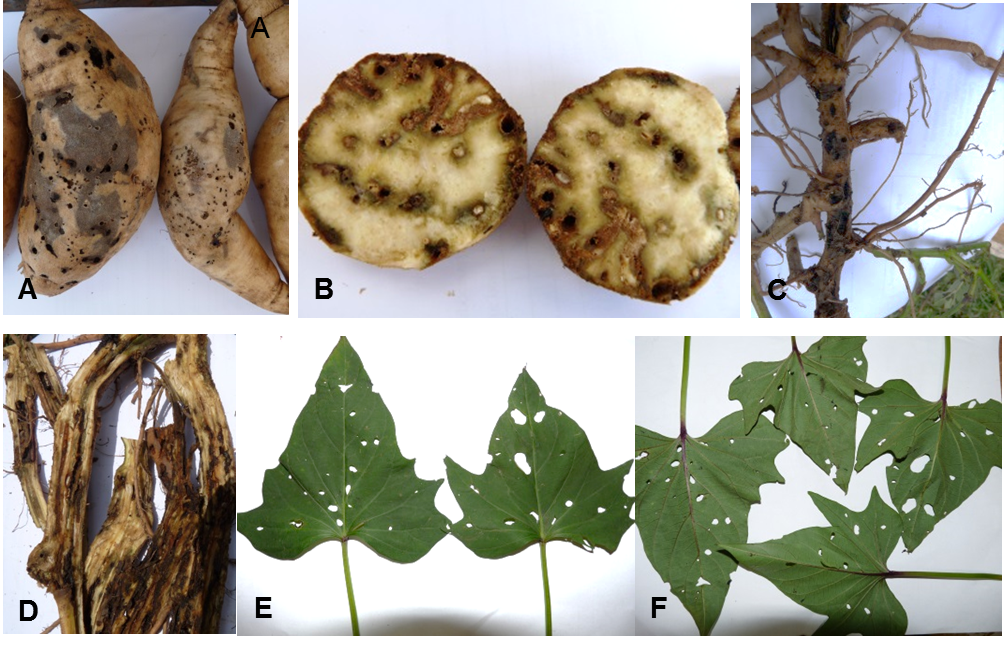
Morphology
Egg
Eggs are oval, pale yellow, and 0.45 x 0.30 mm in size and are deposited individually in a cavity (Photo 2A).
Larva
Larvae are 5–10 mm long and creamy white in color. They are curved, without legs, cylindrical with a prominent head capsule (Photo 2B).
Pupa
Pupae are glabrous, 6–7 mm long with creamy-white cuticle (Photo 2C).
Adult
After enclosing, the adults are white but later turn to gray and black after about 3 days. Adults are slender (5–8 mm long) and have prominent eyes and a conspicuous beak. Antennae of adult male weevils are straight and those of female weevils are club-shaped (Photo 2D).

Biology
After adults emerge, females take 2–24 days before laying eggs, depending on temperature. Eggs are inserted singly into a feeding hole, which the female then seals with a plug of fecal matter. An individual female lays a maximum of 17 eggs per day and a total of up to 545 eggs in 178 days. The maximum number of days an adult weevil can live is 309. Eggs are mostly laid in roots through soil cracks, especially during the dry season, but can also be laid in stems, especially at the stem base if roots are absent. After hatching, the larvae feed inside the root or stem until adults emerge. Larvae bore numerous irregular tunnels and deposit their excreta. A single root or stem can have more than 10 larvae, whose feeding activity severely damages the root.
Temperature-dependent development
Egg-to-adult development of C. puncticollis is possible at temperatures of 17.5°–35°C but not at 15°C or 40°C (see Annex 7.3.4). Total development is almost 6.4 times longer at 17.5ºC (86 days) than at 35ºC (16 days). On average, egg development time is three times faster at 30°C (3.0 days) and 35°C (3.1 days) than at 15°C (19 days). Larval and pupal developmental time is both longest at 17.5°C (60 days for larva and 16 days for pupa) and shortest at 35°C (10 days for larva and 3 days for pupa). The lowest mortality of <1% was observed at 25°–30°C for eggs and pupae, respectively. Larval mortality is lowest (about 16%) at 25°–35°C. At 40°C and 15°C, 100% larvae mortality occurred and no egg-laying was observed at 40°C. Optimal temperature for survival is between 25°C and 30ºC. Oviposition peaked at 30°C, with 350 eggs laid per female; lowest oviposition was registered at 15°C. Senescence rates for both males and females were relatively low (< 0.1), with the lowest rates being observed at 25ºC.
Life-table parameters of C. puncticollis were estimated using various sub-models in an overall deterministic phenology model (see Annex 7.3.4). The intrinsic rate of population increase was highest at 30°C (rm=0.11). The highest values for net reproduction rate (Ro=48) and gross reproduction rate (110) were recorded at 27.5°C. Temperatures of 25°–30°C are most suitable for high reproduction rates of C. puncticollis. The net reproduction indicates that each new generation of C. puncticollis has more daughters than did the previous generation. Mean
generation time (T) was longest at about 22°C (T=120 days) and shortest between 32°C and 34°C (T=30 days). The longest and shortest doubling time (Dt) for C. puncticollis population was at 22°C (Dt=140 days) and at 30°C (about 8 days). The rate of population growth (finite rate of increase) was highest at 30°C (λ=0.12).
Means of movement and dispersal
Adults can fly for up to 1,000 m. They can also crawl, though the exact distance is unknown. Males are more active flyers than females. Long-distance dispersal is through the movement of infested sweetpotato tubers and vines.
Economic impact
Sweetpotato weevils (C. puncticollis and C. brunneus) are the most important pests of sweetpotato in all major sweetpotato-producing countries in Africa. Yield losses are high and can reach 100%, especially during extended dry seasons. Infested roots have a bitter taste and are not suitable for consumption for food or feed. Infested stems produce fewer roots; if the infestation is heavy, the plants can fail to establish. Precise data are missing on the acreage lost to weevil damage.
Geographical distribution
C. puncticollis is thought to have originated in Africa and has still yet to establish itself outside the continent. Today, this weevil occurs in 24 African countries (Fig. 1).
| Africa | Burundi, Cape Verde, Cameroon, Chad, Congo, Central African Republic, DR Congo, Ethiopia, Ghana, Ivory Coast, Kenya, Madagascar, Malawi, Mali, Mozambique, Nigeria, Senegal, Sierra Leone, Somalia, Sudan, Tanzania, Uganda, Rwanda, Zambia |
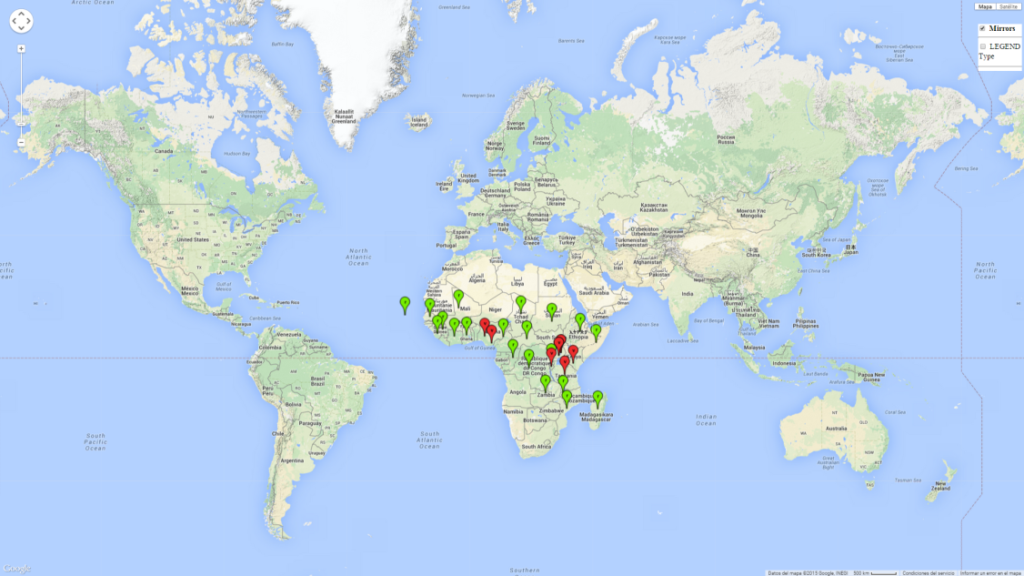
Phytosanitary risks
It is difficult to predict how fast this weevil can spread to new areas. But since the weevil can complete its life cycle at annual mean temperatures of 18°–35°C, all countries and regions with these temperature conditions are potentially at risk for pest establishment. C. puncticollis has been found up to 2,285 masl in southwestern highlands of Uganda. In East and Southern Africa, it is a major quarantine pest and has been officially listed as an A2 pest since 2001. It is also on the A1 list in the European Plant Protection Organisation/EU. According to our
results, the risk for establishment in subtropical and temperate zones is very low, even under the 2050 scenario. C. puncticollis therefore has no potential to establish itself permanently in temperate zones. Our results indicate the need to revise the A2 listing.
Risks mapping under current and future climates
Global Risks
Changes in establishment and future distribution
The establishment risk index (ERI) values (ERI>0.95) predicted by the model under the current climatic conditions compare well to the current distribution of C. puncticollis, actually restricted to Africa (Fig. 2, compare with Fig. 1). Considerable crop damage is noted to be in regions with an ERI>0.95 (West and East Africa). Globally, regions with an ERI>0.95 are considered to be at high risk of C. puncticollis establishment. These regions include most sweetpotato-growing regions near the equator, including South America (Colombia and Venezuela); Central America (Panama and Honduras); the whole of the Caribbean; South Asia (Southern India and Sri Lanka); and Southeast Asia (Malaysia, Philippines, Indonesia, Papua New Guinea, Southern Cambodia, Southern Vietnam, southern Myanmar) under the climate of the year 2000 (Fig. 2A).
Global predictions for 2050 indicate that C. puncticollis will remain a high risk pest (ERI>0.95) for most sweetpotato production areas in tropical countries (a slight decrease of <0.05 is observed) (Fig. 2B, C). A slight increase in the spread of C. puncticollis—but still with a very low establishment potential (ERI<0.6)—is predicted for subtropical regions of Asia (southern China); Europe (Portugal); South America (northern Argentina, Paraguay, Uruguay, southern Brazil); and Southern Africa (South Africa).
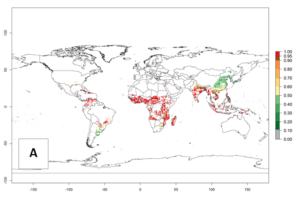 |
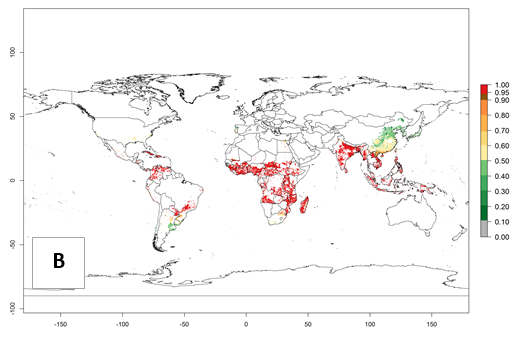 |
Figure 2. Changes in establishment and potential distribution of the sweetpotato weevil, Cylas puncticollis, in sweetpotato production systems worldwide according to model predictions, using the ERI for the years 2000 (A) and 2050 (B), and changes of the ERI between 2000 and 2050 (C). An ERI>0.95 is associated with potential permanent establishment.
Changes in abundance
The model predicted the development of 4–7 and 1–4 generations per year of C. puncticollis in most of the tropical and subtropical sweetpotato-producing regions, respectively, in the year 2000 (Fig. 3A). Two to ten generations per year might theoretically develop in the year 2050 for most of the sweetpotato-producing countries worldwide (Fig. 3B). In most of the tropical and subtropical regions, an increase of 1–3 generations per year can be potentially expected (Fig. 3C). Global maps of the potential population growth in the year 2000 estimate a higher activity in tropical (AI>7–13) than subtropical (AI>2–7) regions (Fig. 3D). Predictions of changes in the activity index (AI) between 2000 and 2050 show a worldwide increase of the AI by a factor of 1–4 (Fig. 3F), with the highest activity in tropical regions (AI>10–16) (Fig. 3E).
| GI | AI | |
| 2000 | 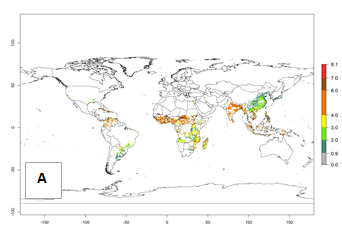 |
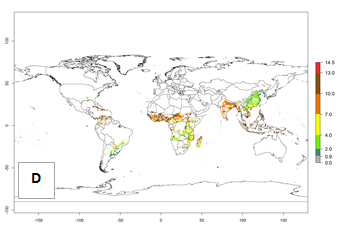 |
| 2050 |
|
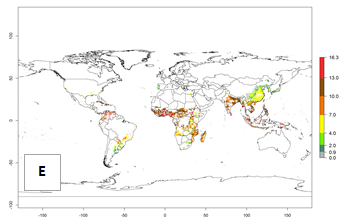 |
| Index change (2000 – 2050) | 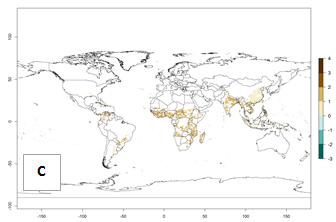 |
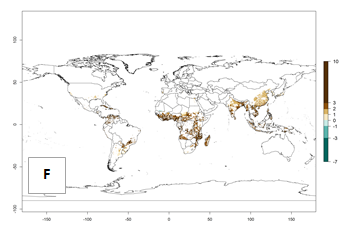 |
Figure 3. Changes in abundance (generation index [GI], damage potential) and activity (AI, potential population growth) of the sweetpotato weevil, Cylas puncticollis, in sweetpotato production systems worldwide according to model predictions, using the GI (A, B) and the AI (D, E) for the years 2000 and 2050, and the absolute index change (C, F).
Regional Risks for Africa
Changes in establishment and future distribution
C. puncticollis occurs naturally in most West and East African countries with an ERI>0.95 (Fig. 4A). Under the year 2050 temperature scenario, the high risk of establishment will potentially remain in many parts of all tropical countries (Fig. 4B, C). A slight increase in the spread of C. puncticollis but with a low establishment potential (ERI<0.7) is predicted for Southern Africa (South Africa). Also, owing to climate change, its range of distribution is expected to expand to higher altitudes in some sweetpotato areas along countries in East Africa (Fig. 4F).
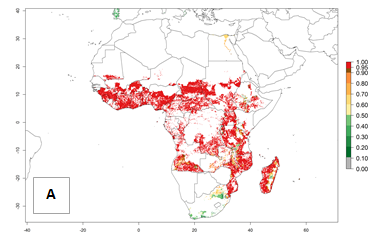 |
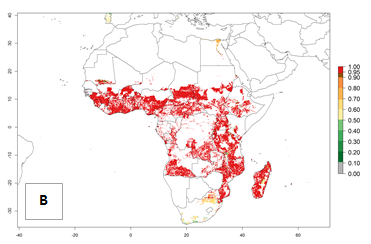 |
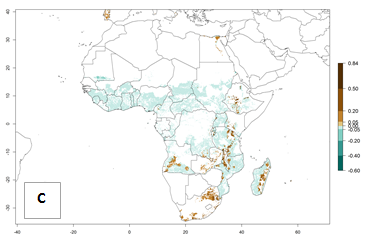 |
|
Figure 4. Changes in establishment and potential distribution of the sweetpotato weevil, Cylas puncticollis, in African sweetpotato production systems according to model predictions, using the ERI for the years 2000 (A) and 2050 (B), and changes of the ERI between 2000 and 2050 (C). An ERI>0.95 is associated with potential permanent establishment.
Changes in abundance
The highest abundance (potential damage) is predicted for most countries of West and Central Africa, where C. puncticollis develops between 4–7 generations per year under the current 2000 climate (Fig. 5A). In East Africa, a GI<6 is estimated. Under the 2050 scenario, an increase in C. puncticollis abundance of mostly 1–2 generations per year is predicted (Fig. 5B, C). Accordingly, a higher potential population growth of C. puncticollis is estimated for most of West and Central Africa (AI>7–13), compared with those for sweetpotato-producing countries in East (AI>2–7) or Southern (AI>1–4) Africa in the year 2000 (Fig. 5D). A potential population increase by a factor of 2–4 is expected for most sweetpotato-producing countries in Africa by the year 2050 (Fig. 5F). Therefore, West and Central Africa will potentially experience the highest potential population increase of C. puncticollis, with an AI>10–16 by the year 2050 (Fig. 5E).
| GI | AI | |
| 2000 | 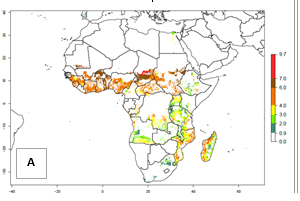 |
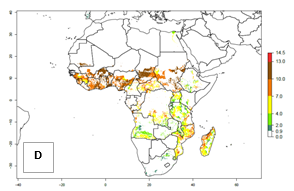 |
| 2050 | 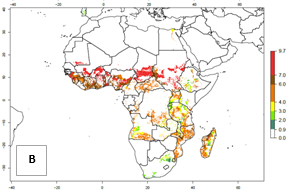 |
 |
| Index change (2000 – 2050) | 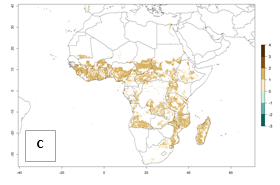 |
 |
Figure 5. Changes in abundance (GI, damage potential) and activity (AI, potential population growth) of the sweetpotato weevil, Cylas puncticollis, in African sweetpotato production systems according to model predictions, using the GI (A, B) and the AI (D, E) for the years 2000 and 2050, and the absolute index change (C, F).
Country Risk Maps
Model predictions for the year 2000 indicate permanent establishment of C. puncticollis (ERI>0.95) in almost all of Uganda, Tanzania, Nigeria (except northern region); Rwanda (except southwestern region); all of Ethiopia except central highlands; and southwestern Kenya (Fig. 6). Of these six countries, Nigeria has the largest area with the highest number of generations (mostly 6) per year (Fig. 6c). Two to three generations of C. puncticollis per year are predicted for most of Rwanda (Fig. 6d). In Uganda, C. puncticollis has the highest number (6) of generations per year in the West Nile sub-region (White/Albert Nile River basin), followed by northern and eastern Uganda, with 4 generations per year (Fig. 6f). In the southwestern and eastern highlands of Uganda (>1,400 masl), C. puncticollis has the lowest number of generations per year (<2). Much of the sweetpotato-growing area in Nigeria has a very high AI (>10–13), indicating a high C. puncticollis population increase within one year (Fig. 6c). In Uganda, the White/Albert Nile River basin has the highest potential for population increase within one year of C. puncticollis (AI=10) (Fig. 6f). Most of the sweetpotato-producing areas in central, eastern, and northern regions of Uganda have an AI>4–7.
| ERI | GI | AI |
a) Ethiopia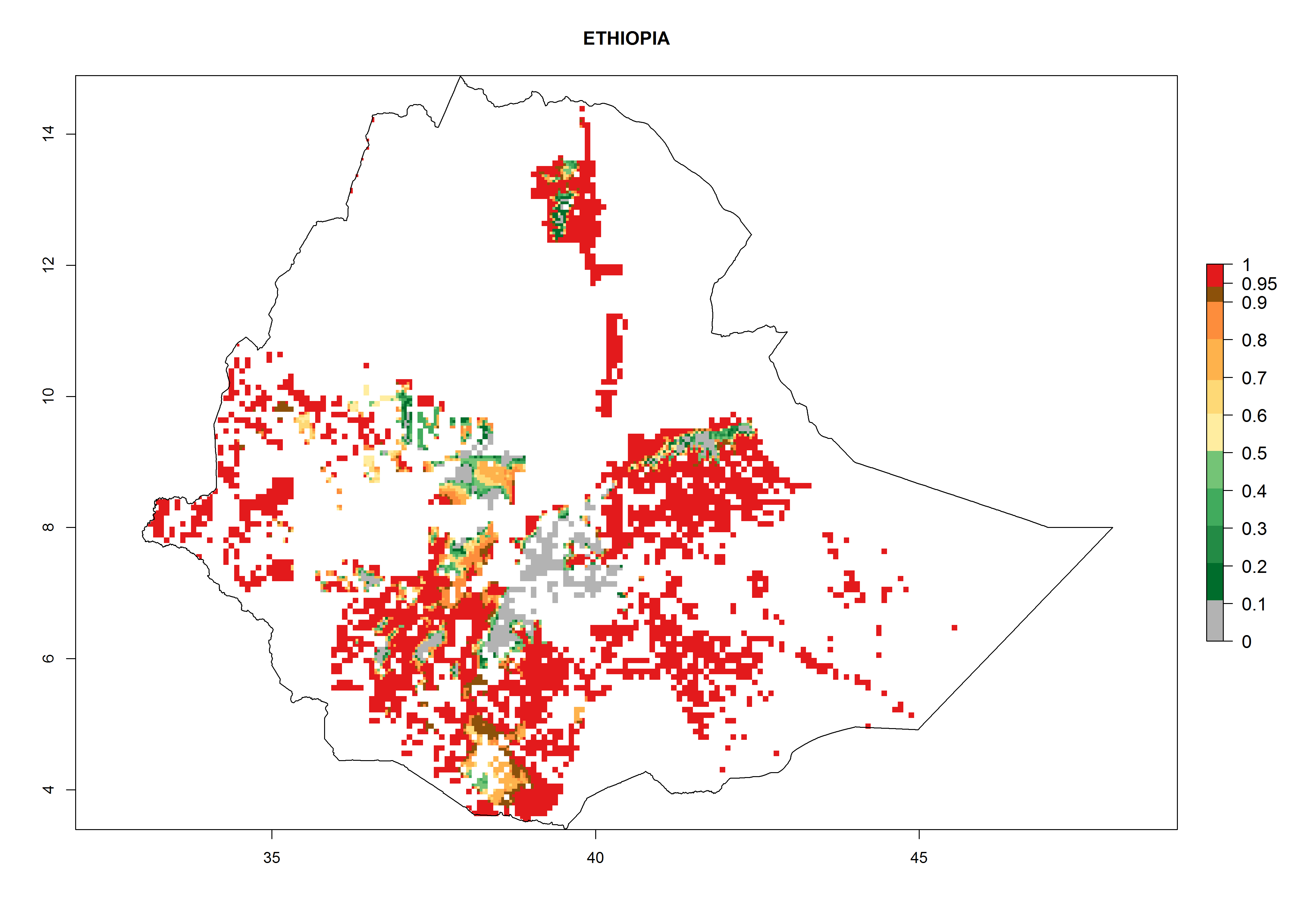 |
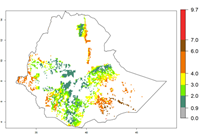 |
 |
| b) Kenya | 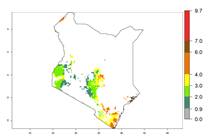 |
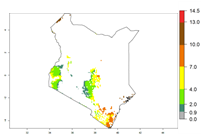 |
c) Nigeria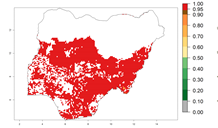 |
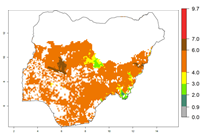 |
 |
| d) Rwanda
|
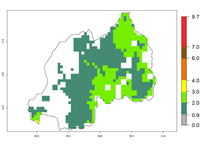 |
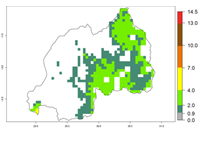 |
e) Tanzania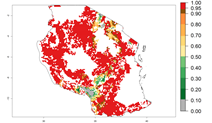 |
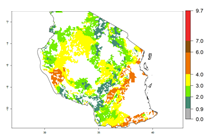 |
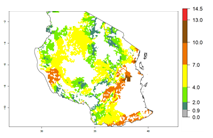 |
f) Uganda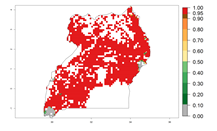 |
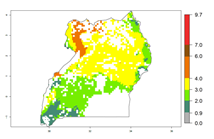 |
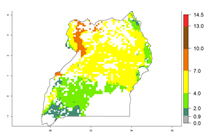 |
Figure 6. ERI, abundance (GI, potential damage), and activity (AI, potential population growth) of the sweetpotato weevil, Cylas puncticollis, in sweetpotato production countries of selected African countries according to model predictions for the year 2000. An ERI>0.95 is associated with potential permanent establishment.
Phytosanitary measures
Use of clean planting material is one step toward delayed field infestation and long-distance dispersal.
Adaptation to risk avoidance at farm level
No single method is effective for complete control of this elusive pest. Control is made difficult because all immature developmental stages occur deep inside the storage root and stem. Even today, not a single effective method is available. We recommend a combination of biological, physical, chemical, and, most important, cultural practices.
Cultural control. Early harvesting has been shown to be the most common method used by farmers in Uganda to reduce root damage. This, in combination with mulching, re-hilling, field sanitation, crop rotation of at least two years, and use of clean planting material, can significantly reduce weevil damage.
Monitoring adult male population. Pheromone traps can be used to monitor pest populations in the field, but these need to be made available commercially.
Chemical control: We recommend proper use of less toxic World Health Organization class II insecticides such as permethrin, dimethoate, and cypermethrin. These can be used for treatment of vines at planting and early in the growing season, at 1 and 2 months after planting. Insecticides applied late in the growing season (after storage root formation) may not be very effective. Use of chemical insecticides in Africa is, however, very low, possibly because most farmers are unfamiliar with the biology and behavior of the weevil or even its presence. This could probably be the reason why, during a survey in Uganda, 87% of the farmers did not control for C. puncticollis.
Biological control. Beauveria bassiana has been successfully used to control C. formicarius in Cuba. This method has not been adopted in Africa to control C. puncticollis for a couple of reasons: unfavorable conditions for the fungal pathogen at the time (dry season) when C. puncticollis infestation and damage is highest (B. bassiana requires moist environments for dissemination), and difficulties involved in production, marketing, and distribution under African conditions.
Host plant resistance. Varieties that are deep rooting or have a lot of root latex can escape C. puncticollis damage or are less infested. But to date, no resistant varieties have been identified.
Further reading
CABI. 1993. Distribution maps of pests. Series A: Map No. 279 (1st Revision) Cylas puncticollis (Fabricius). Wallingford, UK: CAB International Publishing. Available from www.cabi.org
CABI. 2005a. Crop Protection Compendium, 2005 Edition. Wallingford, UK: CAB International Publishing.
European Plant Protection Organization (EPPO). 2013b. Global database Cylas puncticollis. Available from http://gd.eppo.int/taxon/CYLAPU/categorization
Jansson, R.K., and K.V. Raman. 1991. Sweet potato pest management: a global perspective. International Potato Center (CIP), Lima, Peru.
Malgwi, M.A. 2011. Cylas puncticollis Boh.: A New Pest of Cotton: Bioecology, damage potential and control. 156pp. LAP LAMBERT Academic Publishing.
Malgwi, M.A., and I. Onu. 2013. Alternate host plants, hibernation sites and survival strategy of Cylas puncticollis Boh.: A new pest of cotton. Journal of Biology, Agriculture and Healthcare 3(2): 9–22.
Okonya, J.S., and J. Kroschel. 2013a. Incidence, abundance and damage by the sweet potato butterfly (Acraea acerata Hew.) and the African sweet potato weevils (Cylas spp.) across an altitude gradient in Kabale district, Uganda. International Journal of AgriScience 3(11): 814–824.
Smit, N. 1997. Integrated pest management for sweetpotato in Eastern Africa. PhD Thesis, Agricultural University Wageningen, Wageningen, Netherlands. 151pp.

